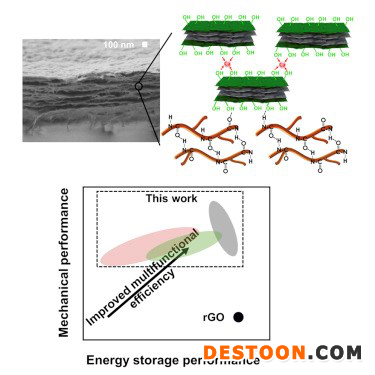
Structural batteries and structural supercapacitors offer a potential solution for electric vehicles (EVs) because they can not only handle structural loads but also store energy and/or produce power. For future ground and air mobility, this offers reduced weight and volume for structures and batteries, as well as more miles between recharging. However, current electrodes for batteries and supercapacitors suffer from poor mechanical performance because they are typically made from brittle materials.
A team led by Texas A&M University (College Station, Tex. U.S.) chemical engineer, Jodie Lutkenhaus, has produced structural supercapacitor electrodes using reduced graphene oxide (rGO), innovative chemistry and aramid nanofibers to mimic the natural material nacre, achieving Young’s modulus and ultimate tensile strength that are 220% and 255%, respectively, higher versus pure rGO electrodes, as well as multifunctional efficiency values of 5–13.6 compared to current electrodes at <1.
Nacre-like multifunctional composite
In an article published in the journal Matter, Lutkenhaus and her team describe using dopamine to functionalize (chemically bond to) rGO and then combine this material with aramid nanofibers to form a composite. The paper explains, “We hypothesized that nature-inspired materials could transform the poor mechanical properties of supercapacitor electrodes into those mimicking nacre, bone, or wood to realize exceptionally high values of multifunctional efficiency.”
Nacre (mother-of-pearl) consists of 95 vol % aragonite (calcium carbonate), chitin, and proteins yet exhibits toughness three orders of magnitude higher than aragonite alone. Its superior mechanical performance results from its hierarchical composite structure: its constituent particles and matrix are organized differently at each geometric scale or level (e.g., nano-, micro-, meso-, macro-) and combine with efficient interfaces between these levels to achieve high modulus and strength while mitigating crack propagation (see the blog “Magnetic 3D printing the next generation of tailored composites”).
The Lutkenhaus team knew that graphene-based nacre-mimicking electrodes have been shown to perform very well electrically. The challenge was to improve their mechanical properties. The team sought to use the hormone and neurotransmitter dopamine to functionalize rGO. Dopamine also self-polymerizes into the highly adhesive polymer polydopamine (PDA). Dopamine mimics the structure of adhesive proteins in nacre-lined mussels, while PDA has been utilized in Li-ion batteries and supercapacitors as an electrode material, separator modifier and binder. However, only a handful of studies have focused on incorporating PDA in rGO composites.
As explained in the Matter technical paper, “We sought to combine for the first time the excellent mechanical properties of PDA-modified rGO with high-modulus, high-tensile-strength Kevlar aramid nanofiber to improve the multifunctional efficiency.” Aramid nanofibers have also been used in a variety of applications including energy storage.




 Lu public network security: 37140202000173
Lu public network security: 37140202000173



